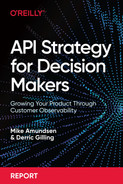Chapter 4. Next Steps
The aim of this report is to introduce the notion of API product strategy and offer a guide to the product strategy journey and some of the key decisions you need to face along the way. This boils down to three key strategic challenges:
-
Committing to an API product approach
-
Managing the product lifecycle
-
Establishing an observability culture
Committing to an API Product Approach
First, in order to build a successful API program, you need to adopt an API product point of view (see Chapter 1). The foundation of a solid product strategy can be summed up in three elements:
-
Market and needs
-
Business goals
-
Key features and differentiators
Knowing your target audience and their needs is the first step. Recognizing where the needs of the market and your business goals overlap helps you keep your efforts focused on profitable work. And targeting key features that separate your APIs from competitors helps ensure your product will stand out in a crowded field (see “Establishing Your API Strategy”).
Managing the Product Lifecycle
The lifecycle of an API product has many steps and requires clear decision-making through the process (see Chapter 2). Once your product is released into the market, you need to make sure developers discover your product when and where they need it (see “Discovery”). You also need to make sure they can adopt your product and incorporate the API into their own lifecycle (see “Adoption”). Of course, it is important to pay attention to the product’s monetization to make sure you are properly monetizing the APIs (see “Monetization”). And finally, you need a transparent deprecation strategy in order to keep your organization focused on useful, profitable API products going forward (see “Deprecation”).
The key to a sustainable API product strategy is to be constantly working the lifecycle, continually renewing your commitment to market needs, creating new products to meet those needs, and observing the constant stream of feedback in order to identify successful APIs and future needs.
Establishing an Observability Culture
Once the strategic decision is made to launch API products, you need a reliable and consistent way to gather key metrics and use those metrics to get a clear view of the state of your products and programs (see Chapter 3). You need more than status reports on individual machines or running services in your IT infrastructure. You also need to track key business capabilities like developer onboarding, time to first hello, and API depth usage in order to identify successful products that need additional funding and support. See a comparison of open source API analytics and monitoring tools.
Building observability into each and every API product you create (see “Implementing API Product Analytics”) makes it possible for everyone in the organization to see which products are successful, which deserve added attention, and which should be closed up in order to better fund the products that are contributing to the company’s business objectives.
What’s Next?
Launching and supporting an API product platform is not rocket science, but it does require lots of decision-making, and good decisions rely on quality information about the market, your APIs, and your customers. Committing to a product-centric approach, diligently tracking your API’s successes, and continually working the product lifecycle are all important elements of a successful API product strategy.
In the end, it’s all about hard work and persistence. As Dan Waldschmidt, author of Edgy Conversations: How Ordinary People Achieve Outrageous Success (Next Century), puts it: “The only thing standing between you and outrageous success is continuous progress.”
